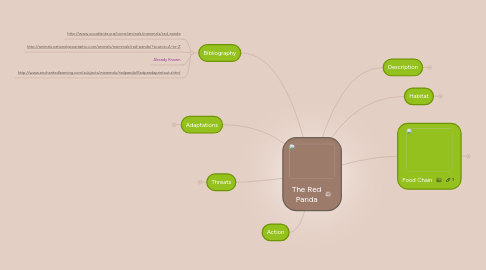The Red Panda
저자: Amelia Ying Xin CHONG


1. Adaptations
1.1. Tail wraps around like blanket for chilly mountain winds
2. Threats
2.1. Habitat loss
2.2. Fur Hunting
3. Action
4. Bibliography
4.1. http://www.zooatlanta.org/home/animals/mammals/red_panda
4.2. http://animals.nationalgeographic.com/animals/mammals/red-panda/?source=A-to-Z
4.3. Already Known
4.4. http://www.enchantedlearning.com/subjects/mammals/redpanda/Redpandaprintout.shtml
5. Description
5.1. The Red panda is the size of a cat, but it's tail makes it slightly bigger than a normal house cat.
5.2. The red panda is dwarfed by the black-and-white giant that shares its name. These pandas typically grow to the size of a house cat, though their big, bushy tails add an additional 18 inches (46 centimeters). The pandas use their ringed tails as wraparound blankets in the chilly mountain heights.
5.3. These animals spend most of their lives in trees and even sleep aloft. When foraging, they are most active at night as well as in the gloaming hours of dusk and dawn.
5.4. Type: Mammal Diet: Herbivore Average life span in the wild: 8 years Size: Head and body, 20 to 26 in (50 to 65 cm); Tail, 12 to 20 in (30 to 50 cm) Weight: 12 to 20 lbs (5.4 to 9 kg) Protection status: Endangered Size relative to a 6-ft (2-m) man:
6. Habitat
6.1. Himalayas
6.1.1. Mountains
6.1.2. Hillsides
6.1.3. Forests
6.2. China
6.2.1. Hills
6.2.2. Mountains
6.2.3. Forests
6.3. Nepal
6.3.1. Mountains
6.3.2. Forests
6.3.3. Hills
6.4. Myanmar
6.4.1. Mountains
6.4.2. Hills
6.4.3. Forests
7. Food Chain
7.1. Bamboo
7.2. Flowers
7.3. Nuts
7.4. Bugs
7.5. Roots
7.6. Mushrooms
7.7. Small Rodents
7.8. What eats Red Pandas
7.8.1. Big Birds
7.8.1.1. Hawks
7.8.1.2. Eagles
7.8.1.3. Condors
7.8.1.4. Vultures
7.8.2. Leopards
7.8.2.1. Common Leopards
7.8.2.2. Snow Leopards
